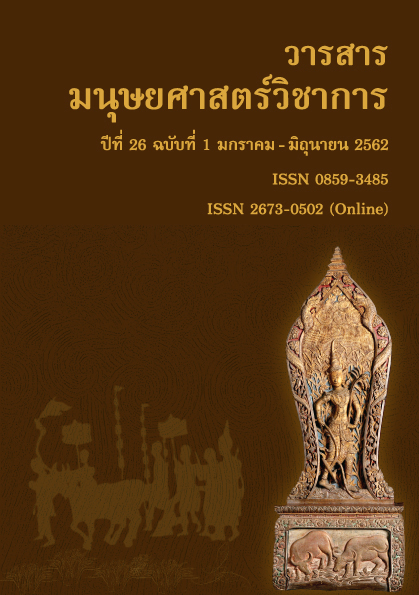กลวิธีการประกอบสร้าง "อำนาจ" "ความรู้" และ "ความจริง" ในวาทกรรมโฆษณาผลิตภัณฑ์ที่ให้ความขาว
Main Article Content
บทคัดย่อ
บทความนี้มุ่งวิเคราะห์กลวิธีการประกอบสร้าง “อำนาจ” “ความรู้” และ “ความจริง” ในวาทกรรมโฆษณาผลิตภัณฑ์ที่ให้ความขาว ที่แพร่ภาพทางสถานีโทรทัศน์ โดยอาศัยทฤษฎีกลวิธีการโน้มน้าวใจของอาริสโตเติล คือ 1) ความน่าเชื่อถือของบุคลิกลักษณะของผู้นำเสนอสินค้า ทั้งแพทย์หรือผู้เชี่ยวชาญหรือนักแสดงโฆษณา 2) ตรรกและเหตุผลในภาพยนตร์โฆษณา และ 3) กลวิธีการใช้ภาษาในการโน้มน้าวใจที่สร้าง “มายาคติ” หรือ “ความจริงเสมือน” ของความขาวและความงาม ที่สัมพันธ์กับทฤษฎีสัญวิทยาของรอล็อง บอร์ต นอกจากนั้น การใช้สัญญะ “ความขาว” ยังสอดคล้องกับแนวคิดการประกอบสร้าง “วาทกรรม” ของมิแชล ฟูโก ดังนั้น การตัดสินใจซื้อสินค้านั้นๆ จึงอาจมิได้มาจากความจำเป็นในการบริโภคสินค้ำ แต่ด้วยอำนาจของวาทกรรมที่สร้างความหมายบางอย่างให้ดูเหมือนเป็นเรื่องธรรมชาติและจำเป็นต่อชีวิตของผู้คนทั้งหลำย ที่สอดคล้องกับทฤษฎี “กำรสร้างภาพเสมือน” ของฌ็อง โบดริยาร์ สิ่งนี้ก่อให้เกิดแรงกระตุ้นบางประการที่มีผลกระทบต่อจิตใจของผู้บริโภคที่อาจตกเป็นเหยื่อของโฆษณาเหล่านั้นได้อย่างง่ายดาย
Article Details
เอกสารอ้างอิง
ไชยรัตน์ เจริญสินโอฬาร. (2551). ภาษากับการเมือง / ความเป็นการเมือง. กรุงเทพฯ: มหาวิทยาลัยธรรมศาสตร์.
ไชยรัตน์ เจริญสินโอฬาร. (2554). วาทกรรมการพัฒนา: อำนาจ ความรู้ ความจริง เอกลักษณ์ และความเป็นอื่น. (พิมพ์ครั้งที่ 5). กรุงเทพฯ: ศูนย์วิจัยและผลิตตำรา มหาวิทยาลัยเกริก.
ทิสวัส ธำรงสานต์. (2558). รายงานวิจัยฉบับสมบูรณ์เรื่อง “สามัญทัศน์และอัตลักษณ์ของ “ความเป็นไทย” ในวาทกรรมของหนังสือคู่มือนำเที่ยวภาษาฝรั่งเศส: มโนทัศน์แห่งความจริงหรือมายาคติ”. นครปฐม: คณะศิลปศาสตร์และวิทยาศาสตร์ มหาวิทยาลัยเกษตรศาสตร์ วิทยาเขตกำแพงแสน.
ธีรยุทธ บุญมี. (2551). การปฏิวัติสัญศาสตร์ของโซซูร์ เส้นทางสู่โพสต์โมเดอร์นิสต์. กรุงเทพฯ: วิภาษา.
นพพร ประชากุล. (2554). คำนำเสนอ. ใน ร่างกายใต้บงการ ปฐมบทแห่งอำนาจในวิถีสมัยใหม่ (ทองกร โภคธรรม, ผู้แปล). (พิมพ์ครั้งที่ 2). กรุงเทพฯ: คบไฟ.
มิแช็ล ฟูโกต์. (2554). ร่างกายใต้บงการ ปฐมบทแห่งอำนาจในวิถีสมัยใหม่ (ทองกร โภคธรรม, ผู้แปล). (พิมพ์ครั้งที่ 2). กรุงเทพฯ: คบไฟ.
ราชบัณฑิตยสถาน. (ม.ป.ป.). พจนานุกรมฉบับราชบัณฑิตยสถาน พ.ศ.2554. สืบค้นเมื่อวันที่ 5 ธันวาคม 2560 จาก http://www.royin.go.th/dictionary/.
ราชบัณฑิตยสถาน. (ม.ป.ป.). ศัพท์บัญญัติราชบัณฑิตยสถาน. สืบค้นเมื่อวันที่ 5 ธันวาคม 2560 จาก http://rirs3.royin.go.th/coinages/webcoinage.php.
อานันท์ กาญจนพันธุ์. (2555). คิดอย่างมิเชล ฟูโกต์ คิดอย่างวิพากษ์. เชียงใหม่: มหาวิทยาลัยเชียงใหม่.
Amossy, R. (2006). L’argumentation dans le discours. (2 éd). Paris: Armand Colin.
Aristote. (1991). Rhétorique (trad. par C.-E. Ruelle, revue par P. Vanhemelryck, commentaires de B. Timmermans). Paris: Librairie Générale Française.
Bacry, P. (1992). Les figures de style. Paris: Belin.
Barthes, R. (1957). Mythologies. Paris: Seuil.
Barthes, R. (1970). L’ancienne rhétorique. Communications, 16, 172-223.
Baudrillard, J. (1970). La société de consommation (Ses mythes / Ses structures). Paris: Danoël.
Baudrillard, J. (1981). Simulacres et Simulation. Paris: Galilée.
Blanchard, S., Korach, D., Pencreac’h, J. et Varone M. (1995). Vocabulaire. Paris: Nathan.
Elias, N. (1983). The Court Society. Oxford: Basil Blakwell.
Eucerin Thailand. (2012). กระจ่างใส ผิวไม่บาง ต้อง Eucerin White Solution. Retrieved December 5, 2017, from https://www.youtube.com/watch?v=tDsaE_iBWeo.
Fontanier, P. (1977). Les figures du discours. Paris: Flammarion.
Foucault, M. (1966). Les mots et les choses. Paris: Gallimard.
Foucault, M. (1969). Archéologie du savoir. Paris: Gallimard.
Foucault, M. (1975). Surveiller et punir. Naissance de la prison. Paris: Gallimard.
Foucault, M. (1995). Discipline and punish. The Birth of the prison. Trans. by Alan Sheridan. New York: Vintage Book.
Fromilhague, C. (2007). Les figures de style. Paris: Armand Colin.
Garnier Thailand. (2015). มิ้นต์ ชาลิดา เผยผิวเนียนเรียบ รูขุมขนกระชับทันที การ์นิเย่ ซากุระ ไวท์ เซรั่ม ครีม SPF21/PA+++. Retrieved December 5, 2017, from https://www.youtube.com/watch?v=YO558Ddj4SQ.
Guillemette L. et Cossette, J. (n.d.). Déconstruction et différance. Retrieved December 5, 2017, from http://www.signosemio.com/derrida/deconstruction-et-differance.asp.
Jakobson, R. (1963). Essais de linguistique générale : Les fondations du langage (Traduit par N. Ruwet). Paris: Éditions de Minuit.
Klein-Lataud, C. (1991). Précis des figures de style. Toronto: Édition du GREF.
Lacan, J. (2006). Séminaire Les quatre concepts fondamentaux de la psychanalyse. Les fondements de la psychanalyse. Essaim 2006/2, 17, 65-82.
Maingueneau, D. (2002). Analyser les textes de communication. Paris: Nathan.
Molinié, G. (1992). Dictionnaire de rhétorique. Paris: Librairie Générale Française.
Mulvey, L. (1975). Visual Pleasure and Narrative Cinema. Screen, (16/3), 6-18.
Nivea. (2017). ใหม่ นีเวีย เอ็กซ์ตร้า ไวท์ ผิวเนียนใส ดุจทาทรีตเมนต์. Retrieved December 5, 2017, from https://www.youtube.com/watch?v=QQOpnyXx64g.
OMO Thailand. (2014). โอโมพลัส ขาวเหนือชั้น. Retrieved December 5, 2017, from https://www.youtube.com/watch?v=VreLlilQNkI.
Perelman, Ch. (1997). L’empire rhétorique. Rhétorique et argumentation. 3 tirage. Paris: Librairie Philosophique J. Vrin.
Reboul, O. (1984). La rhétorique. Paris: PUF.
Reboul, O. (2005). Introduction à la rhétorique. (4e éd). Paris: PUF.
Robrieux, J.-J. (2005). Rhétorique et argumentation. (2e éd). revue et augmentée. Paris: Armand Colin.
Saechia, U. (2016). Snowz สโนว์ซ กลูต้า. Retrieved December 5, 2017, from https://www.youtube.com/watch?v=o_bKwMyjVcs.
The White Man’s Burden : Kipling’s Hymn to U.S. Imperialism. (n.d.). Retrieved December 5, 2017, from http://historymatters.gmu.edu/d/5478/
Une histoire oubliée. (n.d.). Jules Ferry et le « droit des races supérieures ». Retrieved December 5, 2017, from http://www.une-autre-histoire.org/jules-ferry-et-le-droit-des-races-superieures/
Une autre histoire. (n.d.). Jules Ferry et le « droit des races supérieures ». Retrieved December 5, 2017, from http://www.une-autre-histoire.org/jules-ferry-et-le-droit-des-races-superieures/


